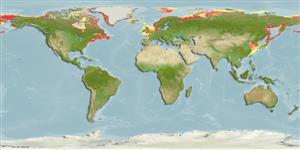Pycnogonida |
Pantopoda |
Nymphonidae
Environment: milieu / climate zone / εύρος βάθους / distribution range
Οικολογία
; εύρος βάθους 0 - 100 m (Αναφ. 256). Boreal
Northwest Pacific, Arctic and Northern Atlantic.
Length at first maturity / Μέγεθος / Weight / Age
Γεννητική Ωρίμανση: Lm ? range ? - ? cm
Trunk glabrous, lateral processes separated by intervals equal to diameters, about 1.5 times longer than diameters. Neck moderately long, ocular tubercle wider than tall, eyes large. Proboscis a cylinder tapering distally. Abdomen short, not as long as fourth lateral processes.
Chelifore scapes as long as proboscis, palm rectangular, with many ventral setae, fingers shorter, slender, carried at acute angle, armed with many tiny teeth. Palp second and third segments subequal, fourth very short, fifth about as long as third, distal 2 segments with many short setae. Oviger terminal claw with many tiny teeth. Legs long, slender, tarsus about 1.5 times longer than slender propodus, both with tiny sole spines. Claw slender, slightly less than half propodus length, auxiliaries less than 0.3 main claw length (Ref. 2153, p. 23).
Shelf (Ref. 19). Sublittoral (Ref. 256).
Life cycle and mating behavior
Γεννητική Ωρίμανση | Αναπαραγωγή | Γεννοβολία | Eggs | Γονιμότητα | Larvae
Members of the class Pycnogonida are gonochoric and sexually dimorphic. During copulation, male usually suspends itself beneath the female. Fertilization occurs as the eggs leave the female's ovigers. Males brood the egg masses until they hatch. Life cycle: Eggs hatch into protonymphon larva then to adults.
King, P.E. 1973 Pycnogonids. Hutchinson of London. London, UK. 144 p. (Αναφ. 12)
IUCN Red List Status
(Αναφ. 130435: Version 2025-1)
CITES status (Αναφ. 108899)
Not Evaluated
Not Evaluated
Threat to humans
Human uses
| FishSource |
Εργαλεία
Περισσότερες πληροφορίες
Τροφική ΟικολογίαFood items (preys)
Σύσταση δίαιτας
Κατανάλωση τροφής
Θηρευτές
Population dynamicsΑύξηση
Max. ages / sizes
Length-weight rel.
Length-length rel.
Length-frequencies
Mass conversion
Αφθονία
Life cycleΑναπαραγωγήΓεννητική ΩρίμανσηΓονιμότηταΓεννοβολίαEggsEgg developmentLarvae PhysiologyΚατανάλωση οξυγόνου
Human RelatedStamps, coins, misc.
Διαδικτυακές πηγές
Estimates based on models
Preferred temperature
(Ref.
115969): 0.4 - 11.5, mean 3 (based on 1310 cells).
Price category
Unknown.
